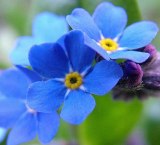Trumpeter swans and tundra swans are the two species of swans native to North America, both nesting in Alaska. The tundra swan was formerly named the whistling swan. The trumpeter is the world's largest member of the waterfowl family, with males averaging 28 pounds and females averaging 22 pounds. Eggs of trumpeters sometimes are 5 inches long!
Like all swans, the sexes have identical plumage, and both tundra and trumpeter swan adults are all white. However, in some Alaska locales, iron-rich marshes stain head and neck feathers a rusty color. Feathers of immature swans are an ash gray color, and some gray feathers remain evident on the heads and necks of swans that are 1 and 2 years old.
Trumpeter swans have an angular wedge-shaped head profile, with the black of the bill appearing to merge with the eye. Their bills are all black, with a red border on the mandible (lower jaw). One sure way to identify trumpeters is by their deep, French horn-like call, compared to the higher “whoop” of the tundra swan. Although less than two-thirds the size of trumpeters, tundra swans are often difficult to distinguish from their close relative when seen in the field. Adult tundra swans frequently, but not always, have a yellow spot on their black bill near the eye. Their profile suggests a forehead and the eye appears separate from the bill
Swans pair with mates for life, usually as 2-year-olds, but delay breeding until their third, fourth, or even fifth year. If one of the pair is lost, a new mate will be found before the next breeding season. Because of the lengthy development period for their young, swans begin nesting as early as spring thaw permits.
Trumpeters select a nest site typically in an undisturbed marsh adjacent to a small lake. Tundra swans usually nest on elevated sites near large ponds or lakes that have emergent plant beds. When finished, a trumpeter nest is 6 to 12 feet in diameter and about 1 to 2 feet above water level with a ring of open water surrounding it. The female lays two to seven eggs. Both species of swan migrate as family units or in small flocks comprised of several families and some nonbreeders.
Harlequin ducks are undoubtedly one of North America's most beautiful yet least noticed waterfowl. Members of the family Anatidae, harlequins are more specifically classified as seaducks. As with the other seaducks, such as eiders, scoters, mergansers, and long-tailed ducks, harlequins spend most of the year on the ocean and only travel inland to breed. During winter they live very close to shore diving in rocky intertidal and shallow subtidal waters to feed on invertebrates.
Harlequins are unique among North American waterfowl as they are the only ducks to nest along swiftly flowing rivers and streams. This combination, of nesting along remote mountain streams and wintering along rugged and exposed rocky coastlines is why these birds so often go unnoticed in spite of the males’ colorful and striking appearance. With their color, males blend well into their multicolored and textured backdrop of various algae, mussels, rocks, and frothy waves. Females are less conspicuous. White facial patches on an otherwise chestnut brown body identify the more cryptic females. Males are larger than females, averaging about 1.5 lbs to females 1.3 lbs. This is about half the size of the more familiar mallard.
As with most sea ducks, harlequins do not mature or attain full adult plumage until they are two years old. Young males may be confused for females in their first winter if the subtle differences in plumage are not closely observed. Harlequin ducks live in some of the wildest and most remote habitat in the northern hemisphere. Its choice of rugged often isolated coastal habitats and mountain streams rarely bring it to major waterfowl gathering sites where ducks are most often observed and hunted. Relatively few birds are harvested for sport or subsistence hunting.
The year in the life of a harlequin duck can be divided into 3 primary events: wintering, breeding, and molting. Like most waterfowl, harlequins migrate to a separate breeding area. After spending at least eight months at a coastal wintering area, the advent of spring triggers nesting behavior and this requires a new environment. Paired birds usually depart for breeding streams in late-April or May, but timing varies considerably according to diverse ecological conditions across their broad wintering and breeding range. The migration can be a short "lateral" one, simply flying up a nearby coastal breeding stream, or the trip may be lengthy and protracted.
The widespread harlequin is known to also breed along glacial lakes, in tundra ponds, and perhaps rarely on offshore islets in marine waters. Many nonbreeding birds remain on the coast year-round.
|
|








